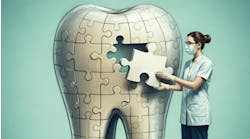Dr. Chonway Tram has a private practice in Rancho Cucamonga, California, that focuses primarily on cosmetics and implantology via CAD/CAM and 3D printing. Dr. Tram currently lectures on implants and 3D printing, and I wanted to talk to him about the impacts of 3D printing on his practice and on dentistry.
Joshua Austin: Dr. Tram, please tell us a little about how 3D printing has impacted your practice.
Chonway Tram: 3D printing has revolutionized the way I practice. It has forced me to rethink what was possible and come up with new ways to improve on traditional dental techniques. In conjunction with intraoral scanning, I have eliminated most parts of impression taking; models can be fabricated on demand; and prosthetics and restorations can be fabricated more affordably, accurately, and with faster turnaround than via traditional approaches. With better restorative resins available, we can perform conservative cosmetic and restorative work that is predictable and with stunning results. I cannot see myself without 3D printers in my office!
JA: Where did you start with 3D printing in your practice, and what was that learning curve like?
CT: I started 3D printing in 2017, using FDM printers to fabricate implant surgical guides, then added DLP printers the year after for models. Dental-specific design programs were limited at that time, so most of my learning came from free software such as Meshmixer. The learning process for 3D printing was frustrating, and the machines were finicky and hard to calibrate to get consistent results. Now, with better printers, software, and resin, my life is a lot easier.
You might also be interested in: How AI can (and will) impact your dental practice
JA: What are the most common things you’re printing today in your practice?
CT: I print the majority of common dental procedures in office. On the restorative front, that includes veneers, inlays/onlays, crowns, and certain types of bridges. Removable prosthetics such as splints, stayplates, and dentures are also printed in office, along with models and wax-ups.
JA: Wow, you are really making the best out of this technology. Are you delivering printed restorations the same day or having patients come back?
CT: It depends on the clinical situation as well as patient urgency. Most restoratives can be delivered same-day, although with veneers, dentures, and such I would work up the case prior to fabrication and delivery.
JA: What do you look for when picking a printer that can handle your needs?
CT: Speed, accuracy, and support. Of these qualities, a company with great support is the most crucial aspect.
JA: Do you use multiple printers, or do you have one single workhorse printer?
CT: I have three printers in the office that I use regularly: the Anycubic Photon Mono X, the Ackuretta Sol, and the Desktop Health Einstein. The Photon is just for models, the other two for restorative/prosthetics. Though the dental-specific 3D printers can handle all the materials I need in the office, having multiple printers aid in efficiency by not having to deal with changing the resin vats constantly.
JA: How did you go about choosing what printer you would use for different types of prints?
CT: For basic model/lab work, any 3D printer will work as long as the resins are validated for dental use and the resolution can handle the details you want, though strength is the limiting factor. For dental-specific 3D printers, the restorative/prosthetic resins available to that printer ecosystem determine my use.
JA: Of the three printers you have, which is easiest to learn and get up and going in a practice and why?
CT: My main printer is the Ackuretta Sol. Small footprint, hundreds of validated dental resins, a great support generator with Alpha AI—it covers all the bases in a dental office.
JA: What is the most common print for the Ackuretta Sol?
CT: With the Sol, I print splints and restorations such as crowns, inlays/onlays, and Maryland bridges. It’s a workhorse and it’s super accurate.
JA: What was your learning curve like on the Sol? Did it take a bit to home in the workflows?
CT: The printer itself is pretty easy to set up right out of the box. Resin care is the most intricate part for any new 3D printer, but as long as you follow manufacturer’s protocol for the resins, the workflow becomes easy. Most aspects of printing are delegated to my assistants.
JA: Knowing what you know now about 3D printing, what do you wish you knew when you started?
CT: The plastic lining in the bottom of the resin tray is fragile, so never take a metal instrument anywhere near a printer—you’ll end up with a horrific mess! Also, most failures initially come from not preparing the resin properly.
Editor's note: This article appeared in the May 2023 print edition of Dental Economics magazine. Dentists in North America are eligible for a complimentary print subscription. Sign up here.







